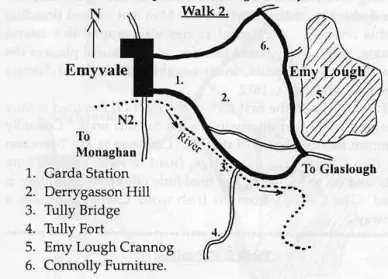
All Content Copyright emyvale.net


Walk 2 (2.5 miles).
From the Leisure
Centre head down
the street to the
Oratory and turn
left onto the
Glaslough Road.
The Garda Station
used be on the
left and hopefully
will be there again
in the not too
distant future. It
was originally
built in the early 1960’s and moved from Main Street. The Hill
on your left is Derrygasson Hill which was one of the McKenna
Seven Hills. It was always called Bonfire Hill, as celebratory
bonfires were usually lit there to mark important events.
Greatest of these was probably the visit of Charles Stuart
Parnell to Emyvale in 1883. The River is on your right and
flowing ‘with’ you.
Derrygasson Lane forks up to the left and is an alternative route
for this walk and while shorter but more difficult because of the
hill climb it is also much safer as the main road has little area to
stand/walk in when traffic is passing. However we continue on
the Main Road.
.75 miles out and Tully Lane is on your right. This leads up past
Emyvale GFC HQ, which was officially opened in 1990, to Tully
Fort. It is all that remains of the McKenna Headquarters from
mid-twelve century to mid-seventeenth century. The small
bridge you would cross as you enter Tully Lane is probably the
oldest bridge on the river but you stay on the Main Road and at
the top of the next hill turn down past Emy Lough. Emy, from
the ancient Irish clan “Uí Meith”, who settled here in the fourth
century, also gives its name to EMYvale. Emy Lough is a well-
known beauty spot in Co. Monaghan and more so since Donagh
Development provided a wonderful Walkway around the Lough.
The Lough has figured prominently in song and story and it is
also known as a very popular place for swans to gather during
the winter months. It is also a wild-life sanctuary and the wild
ducks delight when they see people coming to the Car Park area
as they usually get something to eat. It is also known that
ducks should not be fed with bread.
Emy Lough was full of pike and other coarse fish but in the mid-
fifties the Fisheries Board, in conjunction with local interests,
decided to remove the coarse fish and stock it with Trout. There
were some exceptionally large pike and eels taken from the lake
and transferred to other lakes. However it was impossible to
clear the lake of coarse fish completely and some pike survived
and occasionally cause problems for the trout. Fishermen from
all over come to Emy Lough and the local angling club, set up
by Emyvale Development Association, are to be thanked for the
work they do in promoting and maintaining the fishing interests
and developing the Lough as an attraction.
The Lough was originally much smaller in size but when, in the
1800’s, the Mill Race was formed the Lough doubled in size and
the Sluice was built to control the amount of water needed to
drive the machinery in Emy and Mullan Mills. There was also a
McKenna Crannóg on the Lough but now under water where the
island appears when the Lough is low. McKenna had his HQ on
Portinaghy Hill after Tully was destroyed by the enemy in 1643
and the Crannóg was his place of refuge, if his HQ was
attacked. There was a special causeway to get to the Crannóg
from the far-right corner of the Lough and only residents would
know the path of the Causeway. Legend has it that a Saint or
Holy man had his ‘bed’ on the Crannóg and some would claim
that St. Enda is buried there. It is also thought that the great
Patrick McKenna, McKenna chieftain, was also buried there in
1612.
Head on past the Lough and past Emy Lane on your right and
Connolly Furniture on your left, until you reach the T-Junction.
Turn left here and you will arrive back to the village when you
pass up ‘the Cassey’ to the Main Street. The Cassey comes from
the Irish word ‘Cabhsa’ meaning ‘a pathway’. Turn left again at
Main Street to return to your starting point at the Leisure
Centre.









 Walk 2
Walk 2





